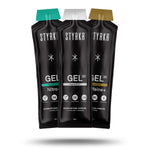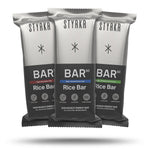Avoid those cotton tees, seams, and opt for a pair of high-quality bib shorts when cycling to prevent chafing and blisters.

Chafing and blisters can be painful. And in some instances, they may derail your ride or force you to cut your long run short. But with proper preparation, you can stay on the road — whether that’s with two feet and a pair of running shoes, or a set of cleats.
Key takeaways:
Why do athletes chafe?
Chafing is caused by friction, both skin on skin and skin against clothing or other equipment. That could be a wetsuit, a pair of cycling bibs, a backpack, or similar.
Endurance athletes are typically at higher risk of chafing than others.
Why? Those are the ones wearing the bibs, running long miles, putting big days in the saddle where rubbing can occur, and wearing wet suits for long periods of time in the water.
If you do chafe, you’re most likely to experience it on your inner thighs, groin, underarms, under breast, and nipples.
Just watch any marathon and you’ll see at least one person with blood on their shirt — they haven’t been in a fight — not that we know of at least — but the sweat combined with the skin on clothing contact breaks the skin and causes bleeding.
What’s the difference between chafing and blisters?
Blisters are areas of skin that bubble and raise whereas chafing is often red, looks blister-like, and is accompanied with a burning sensation.
In some instances, chafing can lead to blisters if the skin is not cleaned and taken care of properly.
Is it normal for chafing to blister?
Chafing can blister if there is repeated rubbing, even after there are red marks.
To avoid blisters after the skin has chafed, clean the skin carefully, using a protective or antiseptic cream, and do your best to minimise rubbing of skin on skin and clothes for the rest of your event, or the next few days.

How to prevent chafing and blisters
- Don’t reuse bibs or other sports kit: wash your kit after using and don’t wear the same pair of bib shorts for more than one ride.
- Apply chamois cream: used to reduce friction and increase protection when riding.
- Clean before and after exercise: shower after exercise to remove sweat, clean areas prone to chafing and blisters, and always wear clean sports kit.
Chafing treatment - what to do!
Clean the affected area as soon as possible and apply an antibacterial cream.
You may also want to bandage the area to prevent further irritation and pain. If the chafing is very painful, you may want to avoid activities that make it worse, or wear loose fitting clothing to minimise rubbing.

The most common types of chafing and blisters
Some areas of the body are more prone to chafing and blisters than others.
Intense exercise, poorly fitted clothes, hot weather, and sweating can all increase the risk of chafing.
The most common types of chasing and blisters you might encounter include:
- Saddle sores
- Blisters on hands
- Jogger’s nipple
- Thigh chafing
- Foot blisters
Saddle sores
Saddle sores are caused by a build-up of pressure, friction, and moisture.
No cyclist is immune, but practising good hygiene and choosing a pair of well-fitting bibs will help protect against them.
A saddle sore is a bacteria-filled pore, they can be painful, often look like a spot or ingrown hair, and might stop you mid-ride to apply a little chamois cream for a bit of relief.
- Apply Sudocrem (or another antibacterial cream) overnight to ease pain and reduce infection.
Blisters on hands
Mountain bikers get hand blisters more than road cyclists. And weight lifters and those new to the gym are also at risk of blisters on hands.
These will typically go away within a few weeks max, and are often harmless.
Jogger’s nipple
Jogger’s nipple, also called runner’s nipple, is when the nipple(s) rubs against a t-shirt.
It’s more common in half-marathon and marathon runners as they’re running longer — there’s a build up of friction and skin-on-clothes rubbing that can be very painful.
The nipple may bleed and cause pain.
Some runners choose to apply lubricating ointment, tape, or plasters, to prevent it. You should also wear a proper running shirt (not cotton) for proper protection.
Thigh chafing
Thigh chafing occurs when your inner thigh rubs against your other thigh, or when it rubs against the saddle, or a piece of clothing.
If you're a cyclist and your bibs do not fit correctly, you’re more at risk of chafing.
And if you’re especially prone to thigh chafing, applying a light bit of chamois cream can work wonders.
Foot blisters
Foot blisters are especially common among runners.
And if you’ve got a pair of poorly-fitting socks or shoes, you’re more at risk.
If your socks or shoes are rubbing, they’ll cause skin-on-skin friction that can be very painful. Blisters are common on the back of the ankles, on the big toes, and the bottom of the feet.
And if you’re wearing a pair of thick socks or poorly ventilated shoes, the excess moisture will only make things worse.
Chafing and cycling
Cyclists commonly encounter chafing, whether you’ve been riding for years or you’ve just started and can barely walk after your first few times in the saddle.
So we thought it was only fitting to dedicate an entire section to cycling and chafing.

What do cyclists use to stop chafing?
Cyclists apply creams and balms, mainly chamois cream, to the chamois of their bibs to reduce friction between the skin, clothing, and their bike seat.
A lot of cyclists use way too much chamois cream — they also too much to the skin, and not enough to the chamois of the bibs.
When using chamois cream, less is more. Apply a light cream to the chamois of the shorts, and a little on more prone areas of your skin to reduce friction and improve comfort on the bike.
How do I stop my groin from chafing while cycling?
If you’re experiencing groin chafing when cycling, you have a few options. We’ll list them from the less expensive to the more expensive:
- Shower before and after every ride
- Apply chamois cream
- Adjust your saddle (or change saddles)
- Invest in a new pair of high-quality cycling shorts
How do I stop my thighs from chafing when cycling?
The above advice directly applies to thigh chafing.
Work your way through the options — there’s usually a simple fix that won’t break the bank. At most, you’ll be out a pot of chamois cream.
Does sweating make chafing worse?
Sweating can make chafing worse. The build up of moisture and sweat can worsen existing chafing and blisters.
Also, when you sweat, salt forms crystals on the body, and once evaporated, it causes additional friction between the skin and clothing.
Is vaseline good for cycling?
Some cyclists use vaseline to reduce friction. However, it’s not the best option (and some people are allergic to petroleum-based products. Therefore, we recommend using a chamois cream for better results.
To summarise
Chafing and blisters can be very painful.
Take the necessary steps to prevent it and treat it when it happens using a protective or antiseptic cream.



